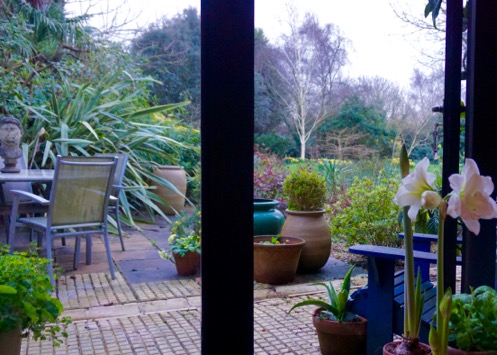Lesson Learned
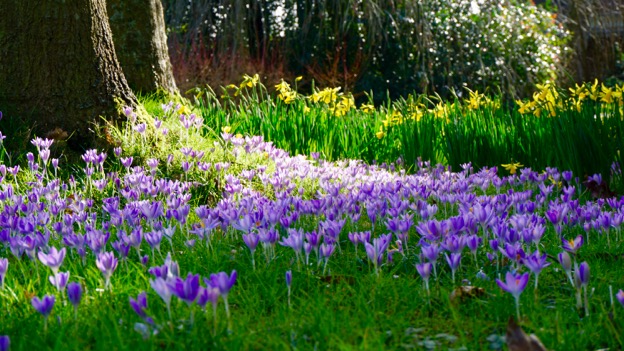
Eyebrows always shoot up when John Brookes, the renowned British landscape designer, declares that garden design is “not about the plants”. He says this to every client, audience, and student emphasizing that no matter how large or small a garden might be, its design must be properly scaled, related to the surrounding architecture and landscape, reflective of its owners’ style and needs, and, of course, well laid out.

After the eyebrows go up, though, and he is sure he has made his point, he concedes that once the design is “right”, then can you think about plants.
I have heard this proclamation too many times to count, so when John recently announced over drinks that there was a half-off sale at his local garden center I was delighted. His hobby is gardening, which he does at Denmans, the 4+-acre garden (open to the public) where he has lived since 1980. In all the years I have known him, however, I have never accompanied John on a plant buying expedition for himself. There was the unmistakable enthusiasm of a plant-loving gardener in his voice so this was going to be fun.
We were among the first to arrive early the next morning, but legions of workers were already on hand to direct cars, restock inventory, and answer questions. They were expecting a huge turnout and they were ready for it.
The atmosphere was festive and the place was packed with shrubs and small trees tucked creatively among miniature waterfalls, pots, tools, small statuary, and other typical nursery ware. Tables and shelves were lined with hundreds of potted bulbs, pansies, primroses, brightly colored ranunculus, and perennials I’d never seen before. Huge signs proclaimed that “Everything Must Go!”. It was fabulous.

A kid in a candy store doesn’t hold a candle to a gardener at a half-price sale. John’s inner gardener was unleashed and I was curious to see what he’d buy. Not permitted to bring anything back home to Washington, of course, I had to settle for the vicarious pleasure of watching a friend indulge.
Much to my delight, John’s first pick were adorable miniature hellebores (Helleborus lividus). Their small leaves are dark marine gray green with silvery veins and its flowers have five delicate perfectly arranged little white petals. Completely irresistible, they bloom mid-winter but must be taken inside (preferably into a cool light place) in frost-prone areas. John grows many different hellebores at Denmans and this blue-gray hellebore will be a great addition for winter visitors to admire.
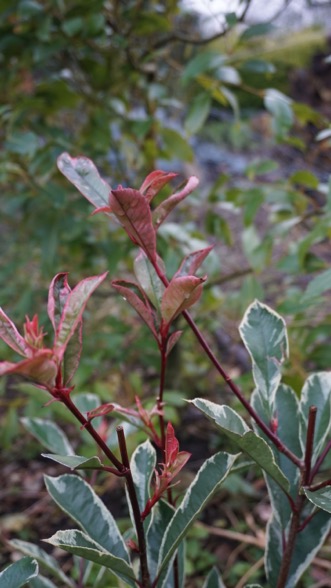
As it happens, John has a good deal of winter interest in his garden. As he points out, you look out your windows and walk through your garden in winter, so you should have fine-looking plants to look at then just as you do in summer. A perfunctory walk through Denmans makes the point. In addition to hellebores, John relies on everything from trees with colored stems and berries to shrubs with variegated leaves for winter interest. It was no surprise, then, that his next choice was a variegated Red Top (Photinia x fraseri “Pink Marble”). The typical form of Red Top has dark glossy green leaves, with distinctive dark mahogany red new growth. The new leaves of “Pink Marble”, on the other hand, start out an eye-catching pink before settling down to a dark green with irregular pinkish-white edges. John will put it at the south edge of his garden where storm damage has left open too many views of the farm fields beyond. Photinia grows quickly, up to 12 feet or so and can be heavily pruned into shape so it will make a good border plant.
Once the photinia was packed into the cart, we were off again. I tried to tempt him with various shrubs that I like, but John was impossible to sway. His pug was in the car so carrying space was limited and there’s nothing that imposes discipline on a gardener like the limits of what you can pack in your car (the pug rode home on my lap) and knowing your garden’s aesthetics.
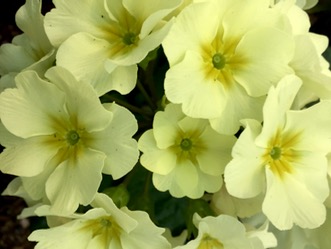
Fortunately, he nabbed a few pots of yellow primroses (Primula elatior 'Veristar Lemon'). Primroses are great companions for spring bulbs, and this one with its clusters of small light yellow flowers on 5-7 inches stems will look fantastic with everything from winter aconite to crocus and miniature iris. The pots John selected had several small plants in them that he will separate before he plants them.
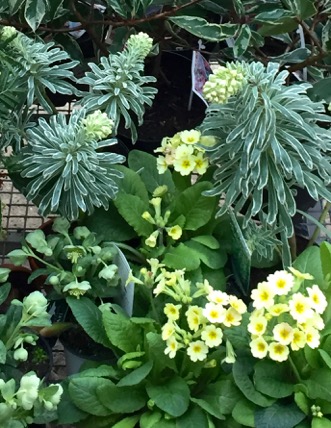
He also chose an elegant spurge (Euphorbia wulfenii ‘Blue Glacier’), with white and grayish variegated leaves. The green-leafed euphorbia blooms for a long time, starting in February. This cultivar is worth growing just for its beautiful leaves, and the clusters of light bluish green flowers, which grow at the top of the 18” stalks, make them even more desirable. It is hardy to zone 5, but I wonder what it would like after being buried by snow?
Having touched and considered pretty much every single plant outside, we went back inside to pay but not before we added one more winter-bloomer to our “haul”. John had spied it on a shelf of small trees as we’d walked in and stopped to pick one up on the way out. Aside from two small pots of white amaryllis, I think this was the closest we had gotten to an impulse buy -- a small mimosa (Acacia dealbata 'Gaulois Astier'), an Australian native with tiny globe-round lemony flowers and soft bright green leaves reminiscent of a conifer’s soft new growth. This acacia is too tender for winters with deep frost, but John will grow it outside his kitchen window where it will be well protected and will reach 12 feet in height. Its early spring blossoms will complement the variegated ivy and choisyas that grow in this space, just as the daffodils finish blooming and the bluebells start. It will definitely enhance the already-lovely view he has from his kitchen.

Back at Denmans, we set John’s new acquisitions where we could admire them. As I stooped to place the last hellebores beside the mimosa, I caught a powerful whiff of flowery perfume. It took me a moment to track the origin of the fragrance down to sweet box (S. hookerianavar. humilis), a low growing glossy leafed shrub with the tiniest pure white flowers. They are so tiny, they are easily missed but you can’t miss their scent. Sweet box, hardy in Washington, is one of the first of early spring’s really fragrant shrubs to break bud and its fragrance is most powerful on a warmish day. A whiff is the ultimate harbinger of spring.
As we settled down to that most English of drinks, a good cup of tea, I kept thinking about John’s comment about design and plants. It’s true: Garden design isn’t about plants – or rather, not about individual plants. It is about creating a framework in which plants are combined based on their form, color, and texture to create a harmonious effect. Each of the plants we brought home fit into Denmans’ framework. Ah, I thought, another lesson learned.
